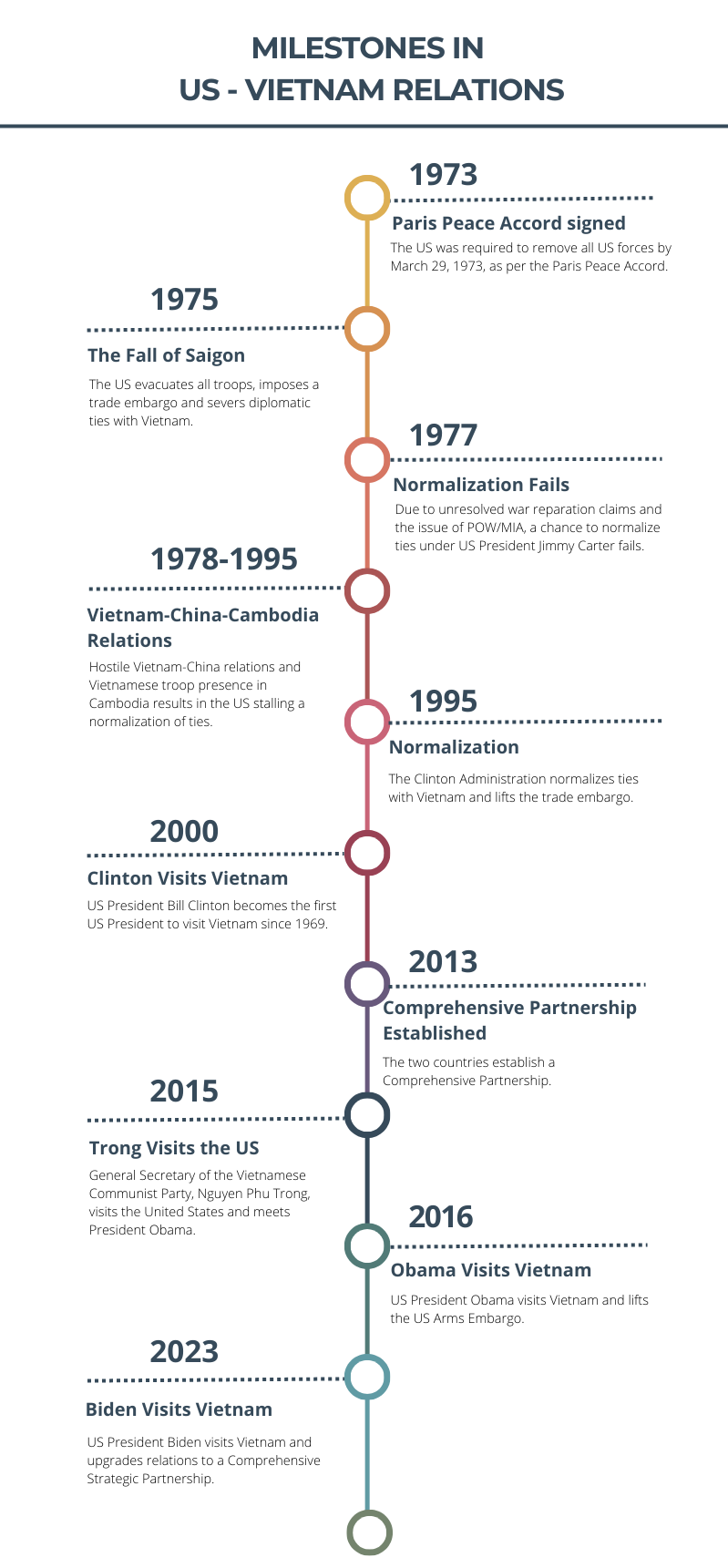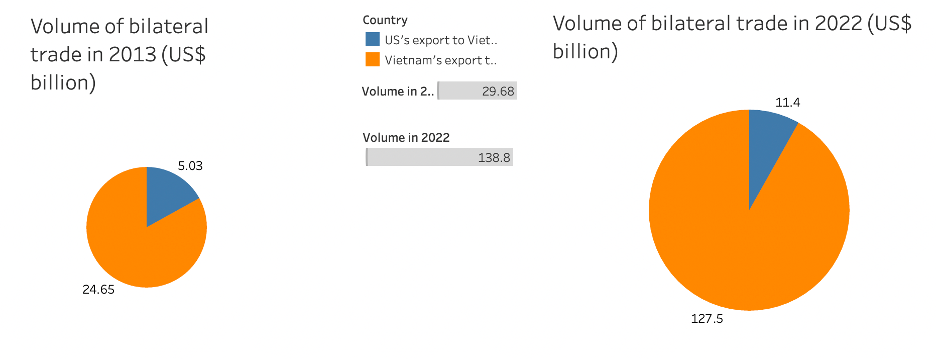The US and Vietnam were enemies 48 years ago. The two countries normalized relations 28 years ago. This September, the two countries made a two-step leap, upgrading relations to a Comprehensive Strategic Partnership.
Milestones in the United States-Vietnam relations
Over the past 50 years, US-Vietnam relations have witnessed several milestones. In 1973, the two countries signed the Paris Peace Accord. Under the Accord, the United States was obligated to remove all remaining US forces from Vietnam. After the fall of Saigon in April 1975, the United States severed diplomatic ties with Vietnam’s new government and imposed a full embargo on the country.
After the Fall of Saigon, there were several efforts to normalize relations with Vietnam, significantly in 1977 under the Carter administration. President Carter had expressed deep interest in bilateral normalization. However, Vietnam’s government insisted the United States pay war reparations, valued at $3.25 billion at that time, which posed a significant barrier to normalization. The United States also demanded a full account of American POWs in Vietnam.
In 1978, the Carter Administration was involved in negotiations to normalize diplomatic relations with China, while Vietnam-China relations were strained at that time. Therefore, Vietnam was not Carter’s top priority.
According to the memoirs of Ambassador Le Van Bang, former Deputy Minister of Foreign Affairs of Vietnam and the first Vietnamese Ambassador to the United States, the two countries historically struggled with numerous misunderstandings, differences in political systems, and notably doubts and suspicions in important issues including accounting American POW/MIA and the Vietnam-Cambodia conflict.
The main objectives of Vietnamese diplomats at that time were to prove and convince the United States there were no American POWs in Vietnam, as well as compromise with the United States in dealing with the Cambodia issue (including withdrawing troops from Cambodia and supporting UNSC resolutions on the Cambodia issue. Finally, the hard work paid off. On July 11, 1995, President Bill Clinton officially announced a normalization of ties with Vietnam.
Since then, the two countries have reached significant achievements, including the US Congress’s approval of a Permanent Normal Trade Relations tag for Vietnam in 2007, upgrading ties to a Comprehensive Partnership in 2013, ending the US arms embargo on Vietnam in 2016, and most recently upgrading ties to a Comprehensive Strategic Partnership in 2023.

Achievements Over the Last Decade
Since the establishment of the Comprehensive Partnership, the bilateral trade in goods has increased nearly fivefold between 2013 and 2022, from $29.6 billion in 2013 to $138.8 billion in 2022.

Currently, the United States is the biggest export market for Vietnam’s goods, accounting for 28.6% of total Vietnam’s exports. In 2021, Vietnam’s exports in goods to the United States reached nearly $101.9 billion, ranking as the 6th largest exporter to the United States, accounting for 3.6% of total US imports.

The United States ranks 11th in countries with FDI investment in Vietnam with the United States investing $11.8 billion as per August 2023, accounting for nearly 2.6% of total FDI in Vietnam. US investment in Vietnam focuses on accommodation and food service, processing industry, and manufacturing. Significantly, in 2022, US Quantum Corporation and Vietnam BB Group signed a cooperation agreement with Quang Tri Province in Vietnam to develop a natural gas and port complex with a total investment capital of over $5 billion. The construction is planned for completion in 2030.
Investment goes both ways. In 2023, a Vietnamese company named Vinfast started construction of a $4 billion electric vehicle factory in North Carolina.

Regarding educational cooperation, in the 2021-2022 academic year, there were 20,713 Vietnamese students who studied in the United States, accounting for 2% of total international students in America, ranking 5th in the list of countries with the highest number of students in the United States.
Interview with Ambassador Pham Quang Vinh – former Deputy Minister of Foreign Affairs of Vietnam, Vietnamese Ambassador to the United States between 2014 and 2018

Photo: Ambassador Pham Quang Vinh, former Deputy Minister of Foreign Affairs of Vietnam, Vietnamese Ambassador to the United States between 2014 and 2018 (source: Embassy of Vietnam in the United States)
Q: During the past 50 years, what were the biggest obstacles to the normalization and growth of Vietnam – US relations? How did the two countries overcome those obstacles?
A: There were two big obstacles to normalization and the growth of bilateral relations, which were the war legacy and differences in the political system. After the war, both sides acknowledged that resolving the war legacy was the most critical issue. The United States emphasized that if the war legacy had not been resolved, it would have been difficult to reach the point of normalization. However, at that time, there was a lot of suspicion, distrust, and misunderstanding between the two sides. How did we overcome it?
Actually, we started to talk with each other. Further, it was the full cooperation from both sides which was recognized by both governments. However, it was not only government-to-government efforts but also people-to-people efforts to heal the wounds in the hearts and minds of people from both sides. People here included both veterans and families of the soldiers from both sides. They reached out to each other, understood the losses from both sides, and then sympathized with each other.
The second obstacle is the differences in the political system. It is always a problem between countries. However, in the case of Vietnam and the United States, we had a war and a lot of wounds, so it was aggravated. To overcome this obstacle, first, we had dialogues on issues of differences such as human rights and democracy. The two countries realized their differences and showed respect for each other’s political system. Second, we expanded cooperation in the fields we have convergent interests, such as war legacy, economic cooperation, technology, and education. Third, Vietnam’s reform and renovation in both economy, political environment, and legal framework helped the two countries come closer to understanding each other.
Q: In your opinion, what are the most successful fields of cooperation between the two countries that can be considered as highlights for bilateral relations? Can you elaborate on that?
A: All fields of cooperation gained significant achievements. For me, economic cooperation should be highlighted in the bilateral relationship. Look at some figures, in 1995, the year of bilateral normalization, the trade volume was about half a billion USD. In 2013, the year of upgrading to a Comprehensive Partnership, it was around US $30 billion. In 2022, it was nearly US $139 billion, a 400% increase from 2013, and 280 times higher than in 1995. In terms of investment, the United States ranks 11th in countries with FDI in Vietnam, with US $11 billion. Though it is not too much, it is a significant number. How could the two countries reach those achievements?
It was due to several reasons. First, the two economies complement each other. Second, Vietnam has been going up in its quality of the economy as well as in the hierarchy of the global supply chain, since Vietnam entered many FTAs, including CPTPP and EVFTA, and currently it is negotiating IPEF with the United States and other members. Vietnam’s goods and services now can be accepted by difficult markets such as American and European markets. The two economies are now intertwined in the global supply chain and value chain. In his recent visit to Vietnam, US President Biden also highlighted trade and economic cooperation.
Q: What is the future path for Vietnam and the U.S. after the upgrade? Which specific fields of cooperation are likely to be the focus of bilateral relations in the coming years?
A: The upgrade has political symbolism. For the first time, Vietnam has strategic partnerships with all countries in the United Nations Security Council. In the statement by the two leaders, they highlighted ten areas of cooperation. So, I think all ten areas will continue to be important for us.
However, as we come to the next stage of bilateral relationship, especially with the prospect of opening up further areas of cooperation, I think that four areas of focus cooperation in the coming years will be: high-tech, innovation, digital cooperation, and green transition due to following reasons: (1) These are new areas of cooperation; (2) Vietnam’s economy is moving to its goals setting for 2030 and 2045; (3) There are a lot of transition in the world that is based on high-tech, innovation, and green economy. Vietnam should follow the trend to upgrade its position in the global value chain; (4) The United States is restructuring the global trade and finding markets that can be considered as secure and reliable. Vietnam can be one of those destinations for both business and high-tech companies.
Besides government-to-government effort, business-to-business effort is also important, which can put all those goals into realization.
The United States’ effort to bring Vietnam into the global supply chain of semiconductor is very important, but Vietnam needs to improve three pivotal areas of the economy including policy framework, infrastructure, and human resources.
Q: We are living in a world of innovation and cooperation, but also hostility and suspicions. Vietnam-US relations have been a model for steady progress in building confidence. When you see other countries who are hostile to one another, how would you advise them to build better relations?
A: First, they should change their perception. Today, the world can no longer be divided into two separate blocks as in the Cold War, at least in the economic aspect. There are always challenges and opportunities. So, countries should not fall into binary thinking.
With the experience of Vietnam, I would suggest a number of “multis”. First, we need “multi” alignments, it means more friends, not relying on any major power. Second, we need “multi” layers in terms of economy. We need to connect to all big markets in the world including Asia, Europe, and North America, especially via FTAs. “Multi” layers will help us upgrade our economies in the global chains. Third, we need “multi-actors”. We need to have good relations with many actors in the region as well as in the world to balance relationships with others. Fourth, we need to embrace multilateralism.
Looking at the case of Vietnam and the United States, we can see that differences can be settled. The approach here is whether you want to settle or not. There are several lessons from different partnerships in the world, especially between Vietnam and the United States that can offer a lot of experience.
Thao Dang is a Young Professional at the East-West Center in Washington. She is a graduate student at the Elliott School of International Affairs, George Washington University, where she is focusing on US foreign policy.